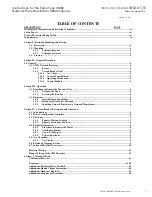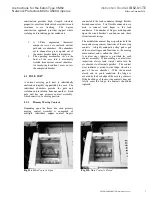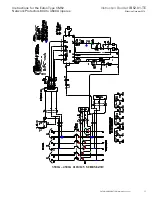
5
Instruction Booklet
IB 52-01-TE
Effective October 2010
Instructions for the Eaton Type CM52
Network Protectors 800 to 4500 Amperes
EATON COrPOrATION www.eaton.com
5 IB -52-01-TE
Effective 11/05/08 (super cedes 11/19/03) IB 52-01-TE
5
Fig. 8a
Breaker in Connect position
Fig. 8b
Breaker in Test position
Fig. 8c
Breaker in Disconnect Position
NOTICE
The circuit break er mechanism is interlocked
such
that
ch arg ed
closed
springs
are
automatically discharged i f the circuit break er is
levered into or out of the CONNECT position.
3.2
ENCLOSURE
The CM52 submersible enclosure is o f welded
steel constru ction, which has b een bonderi zed
and protect ed by several co ats o f high-grade
paint, thereby minimizing corrosion in service.
This enclosure inco rporat es sev eral innovative
features, such as:
1. Side mounted external op eration
handle
2. Internal window hardware
3. Housing Gasket
4. Externally mounted fus e housing or
internal fus e design.
A door is arranged so that it may be hinged on
either side while the clamping bolts are still
supporting the door. The window is made of
tempered glass clamped by gaskets with a
cushioning action to keep the housing watertight.
The operating handle is made watertight through
the enclosure by use o f an O-ring held captive
with a retaining plate.
3.2.1
Outside Operating Handle
WARNING
DO
NOT
MANUALLY
CLOSE
A
PROTECTOR
TO
CONNECT
AN
ENERGIZED TRANSFORMER TO AN
ENERGIZED NETWORK SYSTEM.
The operating handle has three positions: OPEN,
AUTO and CLOSE as indicated on the
nameplate located directly beside the handle.
The handle is held captive in the OPEN and
AUTO position by means of the detent cam, but
is spring returned from the CLOSE position.
External padlock provisions are available in the
AUTO and OPEN modes. It is recommended
that the operator should not normally attempt to
place the Network Protector into service by
utilizing the external handle CLOSE mode. The
protector should be placed in the AUTO position
to permit the MPC series relay to control the
break er actions. An exception to this
recommend ation would be in the initial closing
of a Netwo rk Protector into a known bus which
lacks connect ed load to correctly operat e the
MPC series relay. For this type of operation,
with the housing door of the protector securely
closed, move and hold the external handle to the
CLOSE position. After the protector closes
move the handle to the AUTO position. Do not
drop handle from the close position, this action
could result in the Network Protector opening
and a repeat close operation would be necessary.
















































